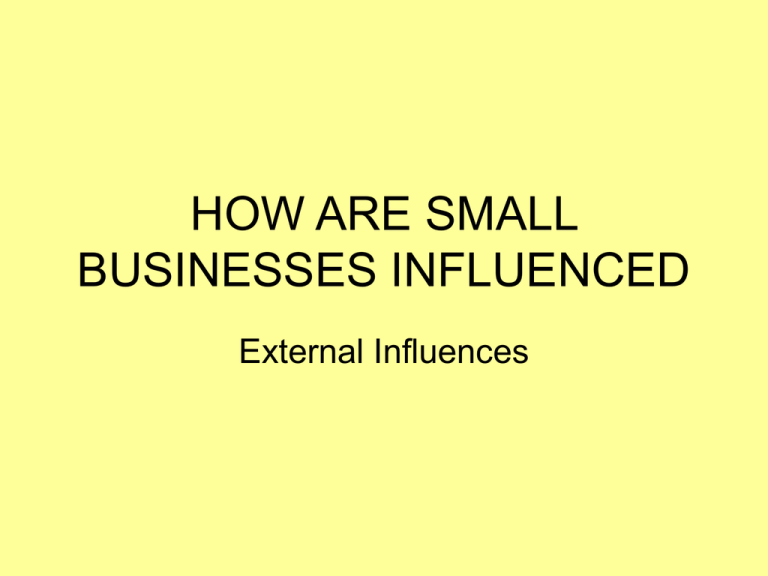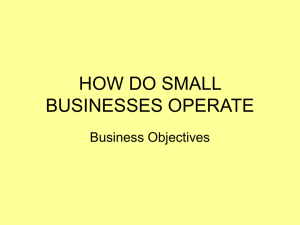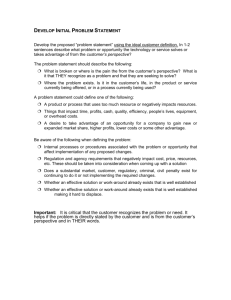3. External influences
advertisement

HOW ARE SMALL BUSINESSES INFLUENCED External Influences LEARNING INTENTIONS AND SUCCESS CRITERIA LEARNING INTENTIONS: I understand how EXTERNAL FACTORS can influence a businesses activities and success. SUCCESS CRITERIA: • I can name the PESTEC factors and give examples of them. • I can show how PESTEC factors can have a positive and negative impact on a business. THE EXTERNAL ENVIRONMENT All businesses must react efficiently to changes in its external environment – failure to do so could be fatal for the future of the business, as we saw in the Old McDonald’s Farm task. The problem is that a business has little control over the external factors and has to continually react to them. EXTERNAL FACTORS External factors can be summarised into categories as follows: P E S POLITICAL ECONOMIC SOCIAL T TECHNOLOGICAL E ENVIRONMENTAL C COMPETITIVE POLITICAL FACTORS The government can introduce laws which can affect every business in the UK. For example the government have set laws which ban advertising tobacco on television. Business must comply with laws or face heavy legal penalties. Local government can decide to give or not give things like planning permission or grants to businesses – GIVE = POSITIVE IMPACT, NOT GIVE = NEGATIVE IMPACT. The government can also affect businesses by changing the amount of Corporation Tax charged on business profits. They have also introduced a Minimum Wage which employers must pay – this will affect their costs and profits. However, sometimes taxes are increased (negative impact) and sometimes they are decreased (positive impact). ECONOMIC FACTORS If the economy is in recession and unemployment is high, consumers will have less income, which will result in a loss of sales for businesses. In order to survive and encourage consumers to buy from them, businesses may have to ‘slash’ prices and accept a cut in profits just to survive. On the other hand, if the economy is showing growth, more people will have employment and more income to spend, leading to increased sales and profits, which businesses can take advantage of. SOCIAL FACTORS There have been changes in the structure of the UK. More people are living longer and so the elderly now make up a larger percentage of the total population. Business must take note of this and produce goods and services relevant to the needs of the population. They must also keep an eye on social trends and tastes and make sure that the goods and services they provide are in line with this. TECHNOLOGICAL FACTORS Businesses must keep up with changes in technology. For example they must get involved in e-commerce, ie, selling goods and services using the Internet. They must also use technology and robots in production lines to make quality products more cost effectively. Failure to keep up with technology due to the high cost of continually buying new equipment could lead to a fall in sales and profits. ENVIRONMENTAL FACTORS There is now increasing pressure for businesses to be environmentally friendly, eg, bags for life and to minimise pollution. This brings extra costs to businesses. If they do not treat the environment with care they may be subject to bad media publicity from pressure groups eg Greenpeace. Business can also be seriously disrupted with extreme weather conditions like storms, floods and snow and need to have emergency plans in place to cope with this. On the other hand, the discovery of new resources can create new markets to work in. COMPETITIVE FACTORS All businesses face competition from other businesses both in the UK and from foreign businesses. For example, when the National Lottery was launched, Littlewoods Pools had to change the way they advertised to compete with the Lottery. IMPACT ON DECISION MAKING All of these external influences are very important to decision making and business activity as they can cause unavoidable problems that the business will have to work hard to react to rather than simply prevent in the first place. This is because they are NOT under the direct control of the business (like internal factors are). In addition, it is worth noting that although all of the above external factors are important, the one which tends to have the most day-to-day impact is the COMPETITIVE factor. This is because competitors change things more frequently than the other factors tend to and so businesses will find they are dealing directly with these issues more regularly. TASKS Now complete Worksheets 18-20 in your jotters.











